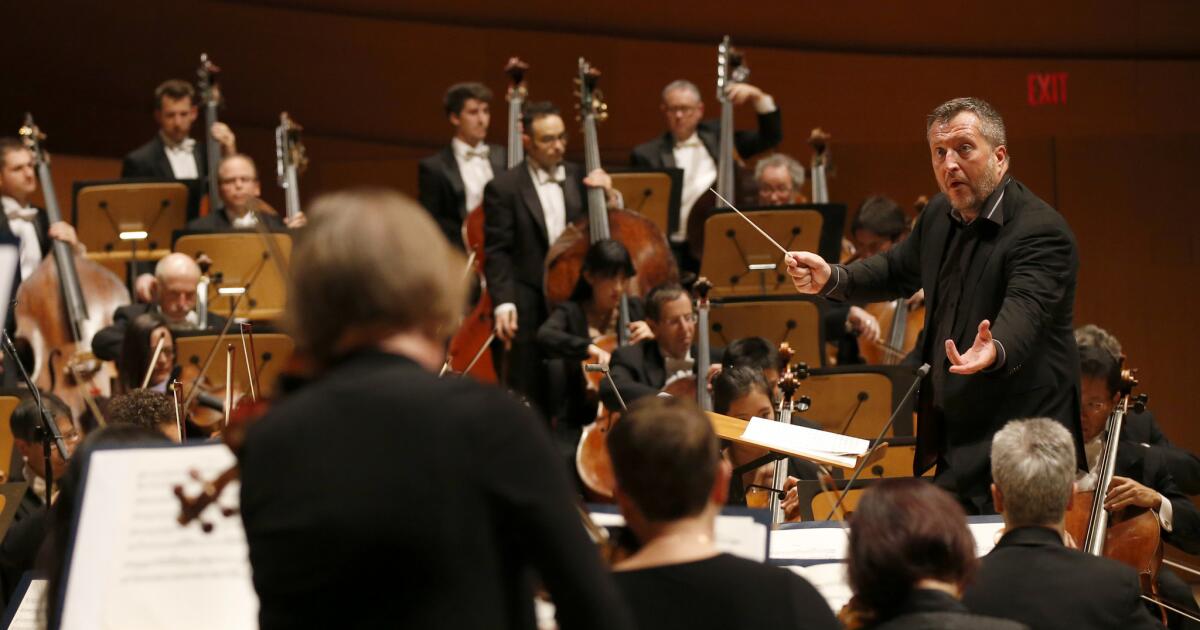Review: Thomas Adès and the L.A. Phil find life in the Dance of Death

Thomas Adès was a dazzling composer in his 20s (and even earlier). By his 30s, he had become one of Britain’s most important musicians. At age 45 and with such recent works as his opera “The Exterminating Angel” (which premiered last summer at the Salzburg Festival), Adès has become an essential composer.
Now a part-time Angeleno and an L.A. composer in as much as he does the bulk of his writing in the Hollywood Hills, Adès is also a force on the local music scene and part of the Los Angeles Philharmonic’s extended family.
Despite all that, there were seeming reasons to resist Adès’ program with the L.A. Phil at Walt Disney Concert Hall on Friday night. He conducted the U.S. premiere of a gorgeous new work for cello and orchestra commissioned by the orchestra as well as the West Coast premiere of his big, startling orchestral work “Totentanz.”
First of all, rain inevitably worsened Friday rush-hour freeways. And who needs the grim news offered by a Totentanz (dance of death) that the Grim Reaper is an equal opportunity choreographer, with something for us all.
But these were not compelling reasons for staying away. The L.A. Phil accommodated latecomers with brief remarks about the program from KUSC’s Brian Lauritzen, and Adès opened with not one but two curtain-raisers before “Lieux Retrouvés,” which featured cellist Steven Isserlis. Dancing Death had to cool his heels until after intermission.
SIGN UP for the free Essential Arts & Culture newsletter »
“Totentanz” is based on a 15th-century frieze in Lübeck, Germany, that was destroyed during World War II. It illustrated with text Death moving down the social scale as he danced with pope, emperor, cardinal, king, monk, knight, mayor, doctor, usurer, merchant, clerk, hand worker, peasant, maiden and child. Scored for baritone and mezzo-soprano and a very large orchestra with a prodigious percussion section dominated by a gigantic taiko drum and a dungeon’s worth of percussive S&M equipment (whips, canes and the like), “Totentanz” was written in memory of Polish composer Witold Lutoslawski and given its premiere at the Proms in London four years ago with soloists Simon Keenlyside and Christianne Stotijn, who also appeared at Disney.
Adès sets his music to the original German text, which is full of subversion. Death cuts the pope down to size (his hat is much too high for his new home), as he does the others. For the high and mighty, the dance is torture. The pitiful cardinal in his clothes of burgundy bemoans that he will soon be worth less than a filthy stinking dog.
Down the line, the less fortunate are better prepared, more connected to nature and more attuned to the notion that death is what makes life meaningful. The peasant feels relief. The maiden will dance as she can, because that’s what maidens do. There is whimsical wisdom, I think, in a babe in arms who must dance before being able to walk. Adès has said that is us all.
What dances these are! The orchestra rushes in with a whoop. Throughout, Adès marvelously distorts the Dies Irae motif that has been used throughout the history of Western music as death’s awful sound. Death and his victims alike are masters of tricky rhythms, the dance of death requiring not so much fleet of foot as fleet of spirit.
Adès takes more time fancifully tormenting the high and mighty than he does the lower orders. When he reaches the merchant, he has the orchestra go crazy, making a place now for fanciful pathos at the end, which is sublimely Schubertean for maiden and, especially, child.
With a slightly awkward manner on the podium while basking in his near decadent orchestral voluptuousness for which there is no contemporary equal, Adès has begun to show increasing command as a conductor as well as interpretive flare. Keenlyside and Stotijn cut a thick, sardonic rug — he demanding, she imaginatively acquiescing.
On the surface, “Lieux Retrouvés” (Recovered Places) is another side of Adès. Originally written eight years ago for cello and piano, it is in four descriptive but sonata-like movements (the rippling of water, a mountain climb to plant a flag, a field at night, a sexy cancan). The lyricism here really is Schubertean. But when it’s strange, it is as strange as Ligeti. The naughtiness, however, is all Adès. The high-flying cello writing is fiendish. The quiet sections test your hearing.
The orchestration adds ravishing colors but blessedly changes little. Perhaps if the cello and piano score weren’t so difficult, these lieux would already have found their place in the repertory. The orchestration, with its glittery delicacy, makes nothing easier, but it does make the music all the more irresistible. And, yes, this is the same mischievous Adès. That last movement is titled “Cancan Macabre,” paving the way for “Totentanz.”
The oddball opening made sense in retrospect. Sibelius’ most miniature (at six minutes) tone poem, “The Bard,” conjures up the mysterious Finnish forest, its harp opening setting the scene for the harp-heavy (elegantly played by Lou Anne Neill) first measures of “Lieux Retrouvés.” Saint-Saëns’ “Danse Macabre” is a merry dance of death with solo violin doing the frolicsome honor of rattling bones. In this context of dancing death, Adés and concertmaster Martin Chalifour offered a hoary bonbon the gift of new life.
Follow The Times’ arts team @culturemonster.
ALSO
Movement as bleak theater, with some terrific Pharrell music too
A British organist reaches America by way of Reykjavik
With violin in hand, Mark Menzies finds hope for the future in the past
More to Read
The biggest entertainment stories
Get our big stories about Hollywood, film, television, music, arts, culture and more right in your inbox as soon as they publish.
You may occasionally receive promotional content from the Los Angeles Times.











